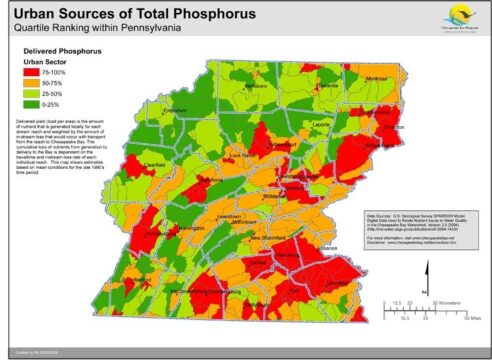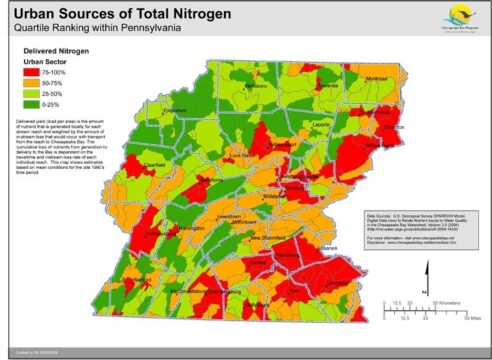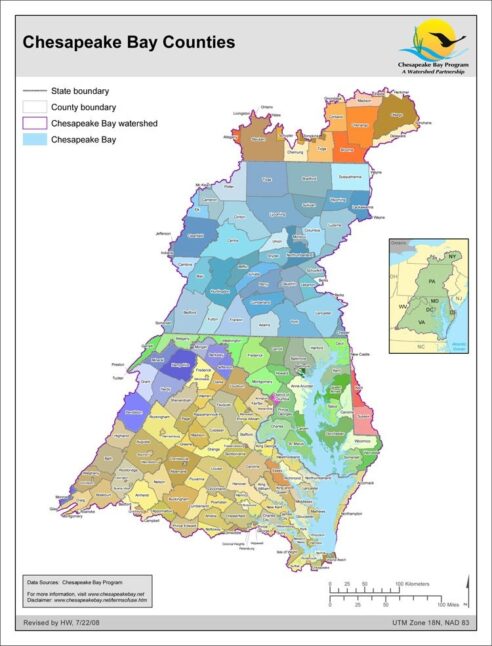Maps
Browse through maps depicting Bay health and restoration, including pollution trends, public access sites and more.
Watersheds Dominated by Existing Use of Exceptional Value or High Quality- PA
Date created: February 27, 2013Existing Use establishes protection for a waterbody on or after November 28, 1975 whether or not that use is included in the water quality standards (25 Pa. Code §93.1 and 40 CFR §131.3(e)). Existing Use is different from a Designated Use; Designated Use is defined for each waterbody or segment whether or not the use is being attained. Existing Use is the actual use the waterbody is attaining at the time of an evaluation. The Department maintains a publicly accessible list of surface water segments where data has been evaluated which indicates an existing use classification of a waterbody that is more protective than the designated use (including those segments which are HQ or EV). Only an existing use which is more stringent than the designated use in §§ 93.9a - 93.9z for a particular waterbody is placed on the existing use list. This GIS watershed layer (which is not part of the Water Quality Standards) is offered to provide a spatial representation of the Aquatic Life Use Tiers contained in the portion of the Pennsylvania Code referenced above. These spatial representations are intended to supplement the Water Quality Standards but should not be substituted for the official version of the standards found in the Pennsylvania Code.
View mapWatersheds Dominated by Existing or Designated Use of Exceptional Value or High Quality- PA
Date created: February 27, 2013Existing Use establishes protection for a waterbody on or after November 28, 1975 whether or not that use is included in the water quality standards (25 Pa. Code §93.1 and 40 CFR §131.3(e)). Existing Use is different from a Designated Use; Designated Use is defined for each waterbody or segment whether or not the use is being attained. Existing Use is the actual use the waterbody is attaining at the time of an evaluation. The Department maintains a publicly accessible list of surface water segments where data has been evaluated which indicates an existing use classification of a waterbody that is more protective than the designated use (including those segments which are HQ or EV). Only an existing use which is more stringent than the designated use in §§ 93.9a - 93.9z for a particular waterbody is placed on the existing use list. This GIS watershed layer (which is not part of the Water Quality Standards) is offered to provide a spatial representation of the Aquatic Life Use Tiers contained in the portion of the Pennsylvania Code referenced above. These spatial representations are intended to supplement the Water Quality Standards but should not be substituted for the official version of the standards found in the Pennsylvania Code.
View mapWatersheds Dominated by Designated Use of Exceptional Value or High Quality- PA
Date created: February 27, 2013Water quality criteria are used to protect designated water uses, such as fish and aquatic life, recreation, and water supply. Designated uses establish the reason for protection and the water quality criteria define the criteria required to protect that benchmark. Use designations and water quality criteria together, constitute Pennsylvania Water Quality Standards as defined in Title 25 Environmental Protection, Department of Environmental Protection, Chapter 93. This GIS watershed layer (which is not part of the Water Quality Standards) is offered to provide a spatial representation of the Aquatic Life Use Tiers contained in the portion of the Pennsylvania Code referenced above. These spatial representations are intended to supplement the Water Quality Standards but should not be substituted for the official version of the standards found in the Pennsylvania Code.
View mapPoint Sources and Priority Agricultural Watersheds - Pennsylvania
Date created: March 9, 2009This map shows the location of point sources of nutrient pollution and priority agricultural watersheds as identified by the Chesapeake Bay Program with input from the Natural Resources Conservation Service (NRCS). Point sources include both monitored and estimated data submitted from or approved by each jurisdiction. Priority agricultural watersheds include SPARROW catchments ranking in the top quartile for delivered loads of nitrogen or phosphorus from agricultural sources normalized by the total amount of agricultural areas within the catchment. The priority areas were further refined to emphasize high loading areas which also contained potential agriculture-related water quality impairments based on individual state 303d (impaired waters) lists.
View mapUrban Sources of Total Phosphorus - Quartile Ranking within Pennsylvania
Date created: March 5, 2009This map shows a quartile ranking within Pennsylvania of the delivered yield (load per area) of Total Phosphorus from urban sources. Delivered yield is the amount of nutrient that is generated locally for each stream reach and weighted by the amount of in-stream loss that would occur with transport from the reach to Chesapeake Bay. The cumulative loss of nutrients from generation to delivery to the Bay is dependent on the travel time and instream-loss rate of each individual reach. This map shows estimates of Total Phosphorus based on mean conditions for the late 1990's time period using the SPARROW model from USGS. SPARROW, or SPAtially Referenced Regressions On Watershed (SPARROW) attributes, uses a nonlinear regression approach to spatially relate nutrient sources and watershed characteristics to nutrient loads of streams throughout the Chesapeake Bay watershed.
View map
Urban Sources of Total Nitrogen - Quartile Ranking within Pennsylvania
Date created: March 5, 2009This map shows a quartile ranking within Pennsylvania of the delivered yield (load per area) of Total Nitrogen from urban sources. Delivered yield is the amount of nutrient that is generated locally for each stream reach and weighted by the amount of in-stream loss that would occur with transport from the reach to Chesapeake Bay. The cumulative loss of nutrients from generation to delivery to the Bay is dependent on the travel time and instream-loss rate of each individual reach. This map shows estimates of Total Nitrogen based on mean conditions for the late 1990's time period using the SPARROW model from USGS. SPARROW, or SPAtially Referenced Regressions On Watershed (SPARROW) attributes, uses a nonlinear regression approach to spatially relate nutrient sources and watershed characteristics to nutrient loads of streams throughout the Chesapeake Bay watershed.
View map
Chesapeake Bay Counties
Date created: July 22, 2008A map showing the counties (and sometimes municipalities) that are entirely or partially within the Chesapeake Bay basin.
View map
